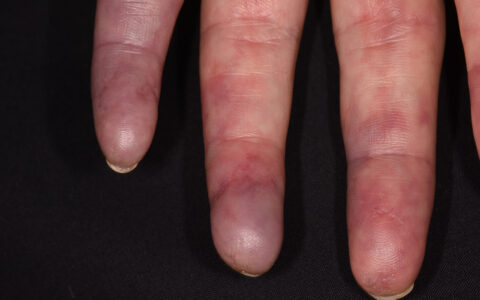Vascular changes that precede the external, visible changes in patients with scleroderma are now being considered a key avenue in efforts to improve care for this sometimes-fatal condition.
Scleroderma, also known as systemic sclerosis, is often thought of as a skin condition, and its detection and treatments have generally not begun until the skin is affected. However, focusing on the vasculature prior to skin involvement may lead to earlier, more effective therapies.
“There’s great interest now in catching the disease quickly, before scarring has occurred, by understanding the vascular involvement early,” said Tracy Frech, M.D., M.S., an associate professor of medicine in the Division of Rheumatology and Immunology at Vanderbilt University Medical Center, who coauthored a recent article on innovations in systemic sclerosis.
“Vascular leakage occurs early in systemic scleroderma, and controlling it offers a promising therapeutic target to curb the progress of key disease processes.”
Critical Warning
“For 16 years, I’ve been studying ways that we can monitor vascular involvement appropriately to develop models of testing to see if the therapies we’re using are being effective,” Frech said.
Monitoring allows Frech to examine underlying causes.
“I focus on trying to understand the involvement of gastrointestinal tract blood vessels and how that translates into symptoms. With skin, we use imaging techniques, but it’s harder to track progression in the GI tract, where we lack access to evaluate those organs in clinic.”
More Than Hard Skin
Scleroderma, which means “hard skin,” has been described in literature since antiquity. It comprises a group of rare autoimmune diseases in which the immune system interacts with blood vessels, causing the creation of scar tissue.
Frech explains that “systemic sclerosis” or “systemic scleroderma” are more appropriate terms.
“Internal organs develop fibrosis, or scarring, too, with the GI tract often involved, and with lung involvement being the most fatal,” Frech said.
Skin symptoms can include stiffening, swelling, and itching; digestive ones can include heartburn and incontinence. When the heart and lungs are involved, dizziness, shortness of breath, and heart failure can occur, she said.
Highly Heterogeneous
“We lump all these patients in one group, but systemic scleroderma is very heterogeneous in its rate of progression and organ involvement,” Frech said.
Although many patients develop fibrotic skin lesions, some do not. Some develop complications in one internal system – digestive, pulmonary or cardiac; others in several.
“Today it’s really difficult for us to predict a particular patient’s course of disease, to know which therapies are going to work best and what kind of outcomes are likely for that patient,” Frech said.
US Registry Among the Largest
To improve understanding, several registries have been created worldwide, some as national efforts and others as multinational ones.
To longitudinally track patients in the United States, the Scleroderma Research Foundation launched the Collaborative National Quality and Efficacy Registry (CONQUER) which serves as a databank and biosample repository. Under Frech’s leadership, Vanderbilt joined CONQUER in 2022.
“The registry lets us look at our patients’ symptoms and see how the different treatments improve those symptoms,” Frech said.
Doctors and patients who take the time to add data to the registry do so as volunteers.
Different Perspectives
Frech is especially enthusiastic about Vanderbilt’s multispecialty approach to scleroderma research and care.
“Justin Baba [Ph.D.] in the School of Bioengineering, for instance, wants to use his field’s tools to study ways that vessels don’t work well and lay down scar tissues instead,” Frech said.
“He told me, ‘We have a lot of optics in development that may be useful. Have you thought about this?’”
She had not, so she asked Baba, a coauthor of the article, to participate in scleroderma work.
Hands-on Care
Frech rejects the idea, which she says circulates fairly widely today, that accruing and analyzing data is all that’s needed to make progress in medicine.
“There’s a perception that we don’t have to touch or talk to the patients, that all we need is blood level and imaging information in a database for us to analyze. But to make progress, we really have to start with the gowned patient in the office,” she said.
This was underscored during the COVID-19 pandemic, Frech explained.
“We lose so much when we take away the physician-patient relationship.”
“When we went remote, we missed really important variations in the data. We couldn’t tell if the person’s illness was progressing,” she said.
The researchers learned that conversing directly with patients and listening to their lungs were critical steps. Without the in-person exam, key information was lacking.
“We lose so much when we take away the physician-patient relationship,” she said.
Registries Lead to Cures
Still, Frech says registry data is critical to help understand ways to support scleroderma patients.
“We won’t have a single cure, but for some subsets of patients, we will figure out ways to treat scleroderma more effectively and to prevent the worst outcomes,” Frech said.
“We will have robust therapies when we have robust registries.”
“For other subsets, we will figure out how to improve itching, burning and ulcerations, and cause them to stop.”
For some subsets or patients, robust therapies may be a while coming.
“We will have robust therapies when we have robust registries.”





